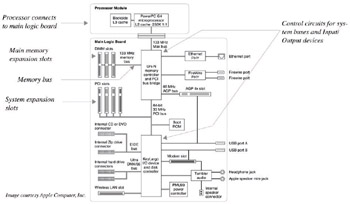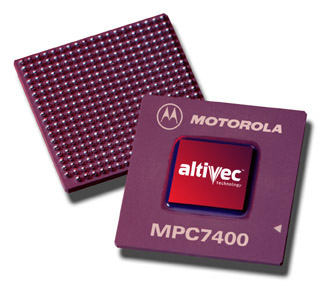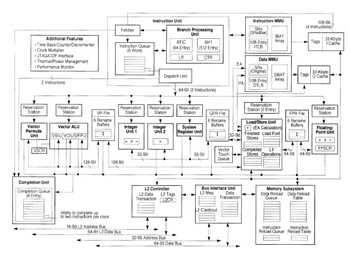What Is A Computer?
|
| < Day Day Up > |
|
A computer is a device whose function, purpose, and behavior is prescribed, controlled, or changed via a set of stored instructions. A computer can also be described as a general purpose machine. One minute a computer may execute instructions making it function as a word processor or page layout machine. The next minute it might be functioning as a digital canvas for an artist. Again, this functionality is implemented as a series of instructions. Indeed, the only difference between the computer functioning as a word processor and the same computer functioning as a digital canvas is in the set of instructions the computer is executing in each case.
Computer vs. Computer System
Due to the ever shrinking size of the modern computer it is often difficult for students to separate the concept of the computer from the computer system in which it resides. As a programmer, you will be concerned with both. By that I mean you will need to understand issues that have a direct bearing on the particular processor that powers a computer system in addition to issues related to the computer system as a whole. Luckily though, as a C++ programmer, you can be extremely productive armed with only a high-level understanding of each. Ultimately, I do recommend spending the time required to get intimately familiar with your programming platform choice. For this chapter I will use the Apple Power Mac G4 as an example, but the concepts are the same for any computer or computer system.
Computer System
A typical Power Mac G4 computer system is pictured in figure 4-1.

Figure 4-1: Typical Power Mac G4 System
The computer system comprises the system unit, monitor, speakers, keyboard, and mouse. The computer system also includes any operating system or utility software required to make all the components work together.
The system unit houses the processor, power supply, internal hard disk drives, memory, and other system components required to interface the computer to the outside world. These interface components consume the majority of available space within the system unit as shown in figure 4-2.

Figure 4-2: System Unit
The processor is connected to the system unit main logic board. Electronic pathways called buses connect the processor to the various interface components. Other miscellaneous electronic components are located on the main logic board to control the flow of communication between the processor and the outside world. Figure 4-3 is a block diagram of a Power Mac G4 main logic board.

Figure 4-3: Main Logic Board Block Diagram
Figure 4-3 does a good job of highlighting the number of computer system support components required to help the processor do its job. The main logic board supports the addition of main memory, auxiliary storage devices, communication devices such as a modem, a wireless local area network card as well as a standard Ethernet port, keyboard, mouse, speakers, microphones, Firewire devices, and, with the insertion of the appropriate third party system expansion card, just about any other functionality you can imagine. All this system functionality is supported by the main logic board, but the heart of the system is the PowerPC G4 processor. Let us take a closer look.
Processor
If you lift up the heat sink pictured in figure 4-2 you’d see a PowerPC G4 processor like the one shown in figure 4-4.

Figure 4-4: PowerPC G4 Processor
The PowerPC G4 7400 microprocessor pictured here runs at speeds between 350 and 500 megahertz with a Millions of Instructions per Second (MIPS) rating of 917 MIPS at 500 megahertz. All this means the G4 is a powerful processor, yet at the time of this writing there are more powerful processors on the market, namely the G5!
The 7400 processor is a Reduced Instruction Set Computer (RISC) meaning its architecture is optimized to execute instructions in as few clock cycles as possible. The block diagram for the 7400 is shown in figure 4-5 and is even more impressive than that of the main logic board. The G4 is a superscalar, pipelined processor. It is superscalar in that it can pull two instructions from the incoming instruction stream and execute them simultaneously. It is pipelined in that instruction execution is broken down into discrete steps meaning several instructions can be in the pipeline at any given moment at different stages of execution.

Figure 4-5: Motorola PowerPC 7400 Block Diagram
Three Aspects of Computer Architecture
There are generally three aspects of processor architecture programmers should be aware of: feature set, feature set implementation, and feature set accessibility.
Feature Set
A processor's feature set is derived from its design. Can floating point arithmetic be executed in hardware or must it be emulated in software? Must all data pass through the processor or can input/output be handled off chip while the processor goes about its business? How much memory can the processor access? How fast can it run? How much data can it process per unit time? A processor’s design determines the answers to these and other feature set issues.
Feature Set Implementation
This aspect of computer architecture is concerned primarily with how processor functionality is arranged and executed in hardware. How does the processor implement the feature set? Is it a Reduced Instruction Set Computer (RISC), or Complex Instruction Set Computer (CISC)? Is it superscalar and pipelined? Does it have a vector execution unit? Is the floating-point unit on the chip with the processor or does it sit off to the side? Is the super fast cache memory part of the processor or is it located on another chip? These questions all deal with how processor functionality is achieved or how its design is executed.
Feature Set Accessibility
Feature set accessibility is the aspect of a processor's architecture you are most concerned with as a programmer. Processor designers make a processor's feature set available to programmers via the processor's instruction set. A valid instruction in a processor's raw instruction set is a set of voltage levels that, when decoded by the processor, have special meaning. A high voltage is usually translated as “on” or “1” and a low voltage is usually translated as “off” or “0”. A set of on and off voltages is conveniently represented to humans as a string of 1’s and 0’s. Instructions in this format are generally referred to as machine instructions or machine code. However, as processor power increases, the size of machine instructions grow as well, making it extremely difficult for programmers to deal directly with machine code.
From Machine Code To Assembly
To make a processor's instruction set easier for humans to understand and work with each machine instruction is represented symbolically in a set of instructions referred to as an assembly language. To the programmer, assembly language represents an abstraction or a layer between programmer and machine intended to make the act of programming more efficient. Programs written in assembly language must be translated into machine instructions before being executed by the processor. A program called an assembler translates assembly language to machine code.
Although assembly language is easier to work with than machine code it requires a lot of effort to crank out a program in assembly code. Assembly language programmers must busy themselves with issues like register usage and stack conventions. High-level languages like C++ add yet another layer of abstraction. C++, with its object-oriented language features, let programmers think in terms of solving the problem at hand, not in terms of the processor.
When you program in C++ you are targeting an abstract machine as defined by the ANSI C++ standard and implemented in a particular compiler and supporting standard libraries.
|
| < Day Day Up > |
|
EAN: 2147483647
Pages: 340